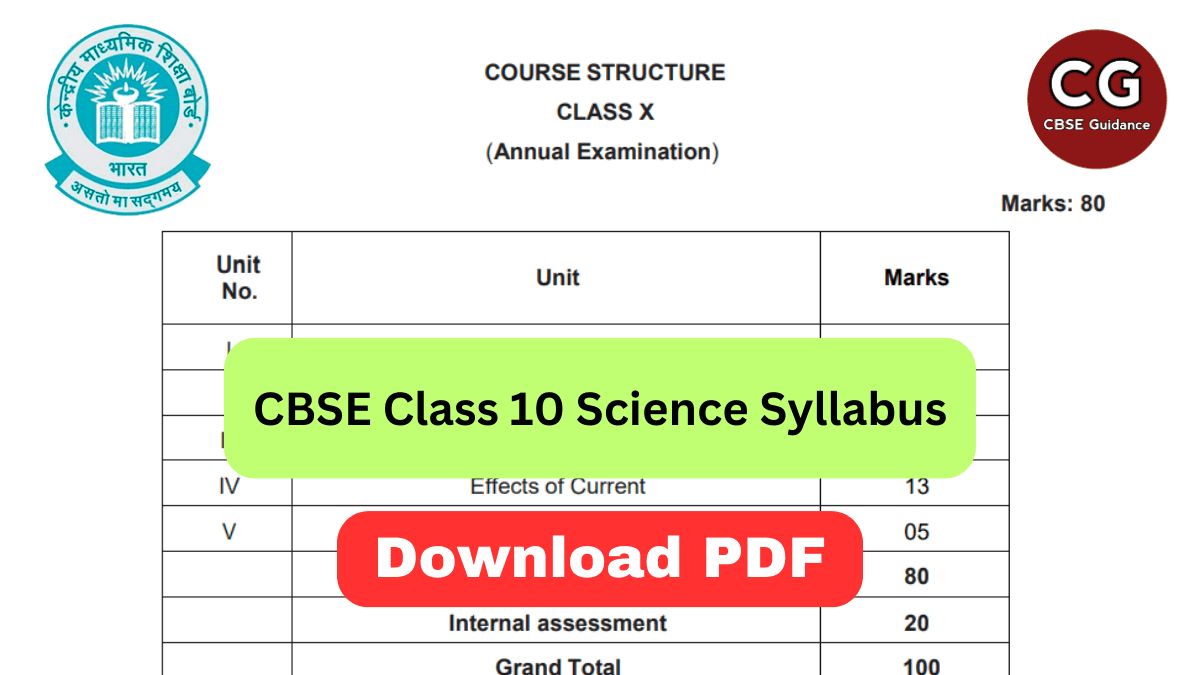Central Board of Secondary Education (CBSE) has officially released the syllabus/curriculum for the Class 10 students for the academic session 2024-25. The syllabus of Class 10 Science remains the same as the previous year. The detailed syllabus is given below for you. You can also take a printout of the syllabus and use it when needed.
| Board | CBSE |
| Class | 10 |
| Session | 2024-25 |
| Subject | Science |
| Content-Type | Syllabus/Curriculum |
| Official Website | https://cbseacademic.nic.in |
SCIENCE (Code No. 086)
CLASS – X (2024-25)
Theory – 80 Marks
Internal Assessment – 20 Marks
COURSE STRUCTURE
| Unit | Marks |
| Chemical Substances-Nature and Behaviour | 25 |
| World of Living | 25 |
| Natural Phenomena | 12 |
| Effects of Current | 13 |
| Natural Resources | 05 |
| Total | 80 |
| Internal Assessment | 20 |
| Grand Total | 100 |
Unit I: Chemical Substances - Nature and Behaviour
Chemical reactions: Chemical equation, Balanced chemical equation, implications of a balanced chemical equation, types of chemical reactions: combination, decomposition, displacement, double displacement, precipitation, endothermic exothermic reactions, oxidation, and reduction.
Acids, bases, and salts: Their definitions in terms of furnishing of H+ and OH– ions, General properties, examples and uses, neutralization, the concept of pH scale (Definition relating to the logarithm not required), the importance of pH in everyday life; preparation and uses of Sodium Hydroxide, Bleaching powder, Baking soda, Washing soda, and Plaster of Paris.
Metals and nonmetals: Properties of metals and non-metals; Reactivity series; Formation and properties of ionic compounds; Basic metallurgical processes; Corrosion and its prevention.
Carbon compounds: Covalent bonding in carbon compounds. Versatile nature of carbon. Homologous series. Nomenclature of carbon compounds containing functional groups (halogens, alcohol, ketones, aldehydes, alkanes, and alkynes), the difference between saturated hydrocarbons and unsaturated hydrocarbons. Chemical properties of carbon compounds (combustion, oxidation, addition, and substitution reaction). Ethanol and Ethanoic acid (only properties and uses), soaps, and detergents.
Unit II: World of Living
Life processes: ‘Living Being’. Basic concept of nutrition, respiration, transport, and excretion in plants and animals.
Control and coordination in animals and plants: Tropic movements in plants; Introduction of plant hormones; Control and coordination in animals: Nervous system; Voluntary, involuntary, and reflex action; Chemical co-ordination: animal hormones.
Reproduction: Reproduction in animals and plants (asexual and sexual) reproductive health - need and methods of family planning. Safe sex vs HIV/AIDS. Childbearing and women’s health.
Heredity and Evolution: Heredity; Mendel’s contribution- Laws for inheritance of traits: Sex determination: brief introduction: (topics excluded - evolution; evolution and classification and evolution should not be equated with progress).
Unit III: Natural Phenomena
Light Reflection and Refraction: Reflection of light by curved surfaces; Images formed by spherical mirrors, the center of curvature, principal axis, principal focus, focal length, mirror formula (Derivation not required), magnification. Refraction; Laws of refraction, refractive index.
Refraction of light by the spherical lens; Image formed by spherical lenses; Lens formula(Derivation not required); Magnification. Power of a lens.
The Human Eye and the Colourful World: Functioning of a lens in a human eye, defects of vision and their corrections, and applications of spherical mirrors and lenses.
Refraction of light through a prism, dispersion of light, scattering of light, and applications in daily life (excluding the color of the sun at sunrise and sunset).
Unit IV: Effects of Current
Electricity: Electric current, potential difference, and electric current. Ohm’s law; Resistance, Resistivity, Factors on which the resistance of a conductor depends. The series combination of resistors, parallel combination of resistors, and its applications in daily life. Heating effect of electric current and its applications in daily life. Electric power, Interrelation between P, V, I, and R.
Magnetic effects of current: Magnetic field, field lines, field due to a current carrying conductor, field due to current carrying coil or solenoid; Force on a current carrying conductor, Fleming’s Left Hand Rule, Direct current. Alternating current: frequency of AC. Advantage of AC over DC. Domestic electric circuits.
Unit V: Natural Resources
Our environment: Eco-system, Environmental problems, Ozone depletion, waste production, and their solutions. Biodegradable and non-biodegradable substances.
Note: The NCERT text books present information in boxes across the book. These help students to get conceptual clarity. However, the information in these boxes would not be assessed in the year-end examination.
Download CBSE Class 10 Science Syllabus for 2024-25 [pdf]
Also See:
CBSE Class 10 English Language & Literature Syllabus 2024-25
CBSE Class 10 Mathematics Syllabus 2024-25
CBSE Class 10 Social Science Syllabus 2024-25 MUST SEE: CBSE Class 10 Notes
